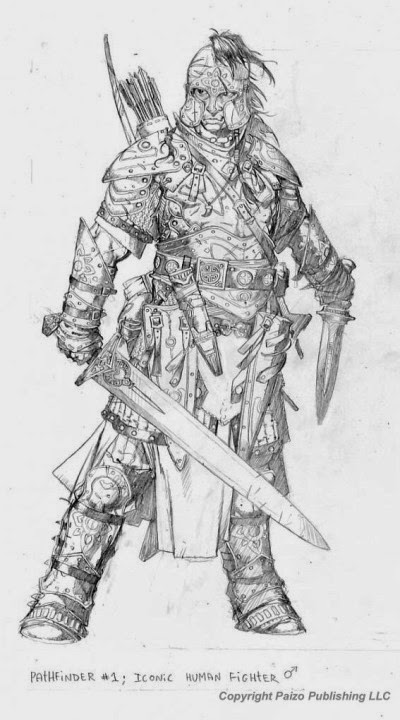 |
| Art by Wayne Reynolds |
The Fighter, like the Rogue and the Monk, seems to receive a decent amount of hate among the Pathfinder community. While the class' access to numerous bonus feats allows players to customize it to their liking, I would be lying if I said it couldn't benefit from some additional rules love.
Recently, I've been toying around with a few house rules that I hope might make the Fighter a little better at its specific niche in the game (i.e. beating the shit out of the bad guys). Some of these changes are rather minor, but others are more significant.
The first minor change was to the fighter's class skills and the number of skill ranks it receives each level. I've always felt the class' skill list was a little lacking, so I revised it to look something like this: Climb (Str), Craft (Int), Handle Animal (Cha), Intimidate (Cha), Knowledge (Dungeoneering) (Int), Knowledge (Engineering) (Int), Perception (Wis), Profession (Wis), Ride (Dex), Sense Motive (Wis), Survival (Wis), and Swim (Str). I've also given the class 4 + Intelligence modifier skill ranks instead of the original amount. I decided to do this so the Fighter could have a few more skill ranks to play around with.
The second minor change was replacing the bonus feat they receive at 1st level with the Combat Expertise feat. Although this might be a strange change, but I'll try to explain my reasoning for it. One of my goals for these house rules was to open new options for the class without forcing it to be dependent on high ability scores. Since almost all of the Improved [Insert Combat Maneuver Here] feats require Combat Expertise (which requires the fighter to have a 13 Intelligence), I feel like giving the class the feat for free at 1st level makes taking those feats at later levels much easier.
Now, I guess I should talk about the bigger changes I made to the Fighter. These two changes (which are honestly more additions than actual changes, but that's digressing from the point) were made with the hope of strengthening the class on two different fronts. The first addition to the class was giving it a good Will Save progression. Fighters tend to really hurt in the Will save department and I like the idea of the class being physically
and mentally strong. This also helps the Bravery ability really shine.
The second addition was a new ability they receive at 1st level called "Fighter's Challenge". As a move action, the fighter can challenge a single opponent he can see. The Fighter receives a +1 bonus on Intimidate, Perception, Sense Motive, and Survival checks against that opponent, a +1 bonus on weapon attack and damage rolls against it, and +1 bonus to combat maneuver checks and his Combat Maneuver Defense against that opponent. These bonuses remain in effect until either the opponent is dead or the fighter challenges a new opponent.
At 5th, 10th, 15th, and 20th levels, the fighter's bonuses against a challenged opponent increase by +1. In addition, at each such interval, the fighter is able to maintain these bonuses against an additional challenged opponent at the same time. The fighter may lose this connection to a challenged opponent as a free action (allowing him to challenge another opponent in its place). At 10th level, the fighter can challenge an opponent as a move or swift action.
I've always liked the idea of the Fighter being able to "challenge" opponents to gain some kind of benefits. This ability is loosely based on the Slayer's Favored Target ability, re-flavored to better fit the Fighter's needs. I also think it will give the Fighter some more options to take within combat and will make things more interesting.
Currently, these changes are untested and I still need to see how they work at the table. I hope these changes and additions will make the Fighter a little better and more interesting to play. What do you guys and gals think?










